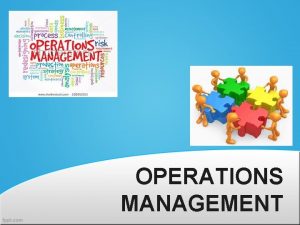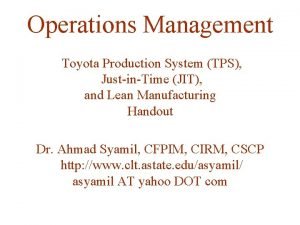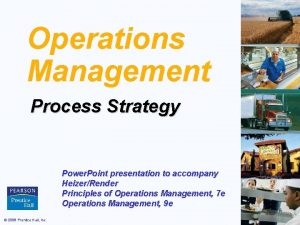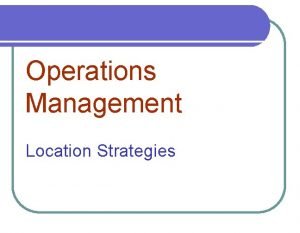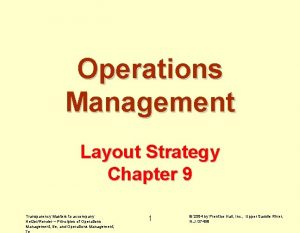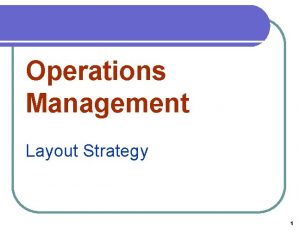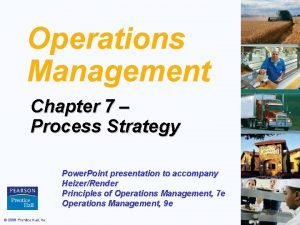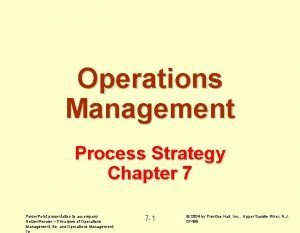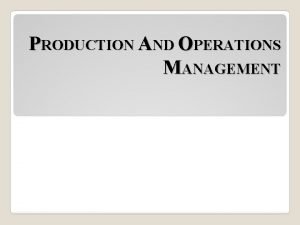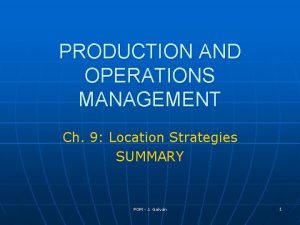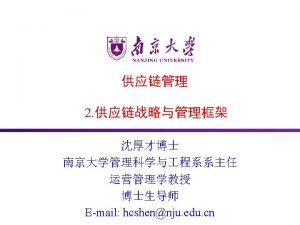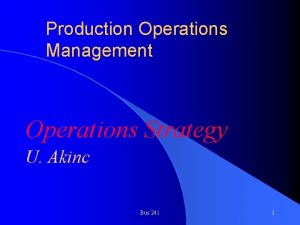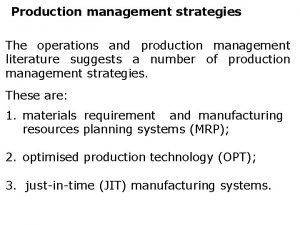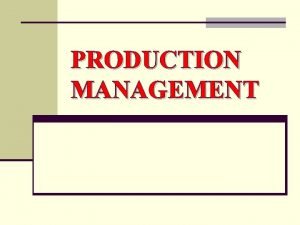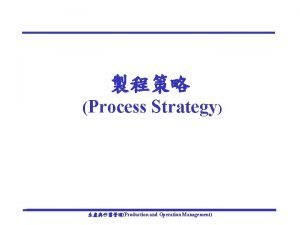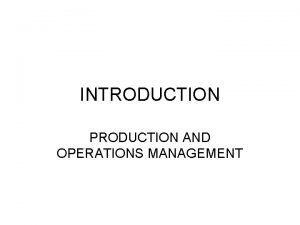PRODUCTION AND OPERATIONS MANAGEMENT Ch 2 Operations Strategy












- Slides: 12

PRODUCTION AND OPERATIONS MANAGEMENT Ch. 2: Operations Strategy for Competitive Advantage POM - J. Galván 1

Operations Strategy Customer Needs Corporate Strategy Alignment Operations Strategy Core Competencies Decisions Processes, Infrastructure, and Capabilities POM - J. Galván 2

Operations Priorities n n n n Cost Quality Delivery Flexibility Delivery Speed Delivery Reliability Coping with Changes in Demand Flexibility and New Product Introduction Speed Other Product-Specific Criteria POM - J. Galván 3

Dealing with Trade-offs Cost Flexibility Traditional Approach Delivery Quality Plant within a Plant (PWP) World Class Manufacturing FOCUS Advanced Approaches Trade-offs POM - J. Galván 4

World-Class Manufacturing World-class manufacturers no longer view cost, quality, speed of delivery, and even flexibility as tradeoffs. n. They have become order qualifiers. n. What are the order winners in today’s market? n POM - J. Galván 5

Service Breakthroughs n Service can be an “order winner” Warranty Travel Planning Leases Roadside Assistance POM - J. Galván Loaner Vehicles 6

A Framework for Manufacturing Strategy Customer Needs Strategic Vision New and Current Products Performance Priorities and Requirements Quality, Dependability, Speed, Flexibility, and Price Enterprise Capabilities Operations & Supplier Capabilities Technology Systems People R&D CIM JIT TQM Distribution Support Platforms Financial Management POM - J. Galván Human Resource Management Information Management 7 8

Strategy Begins with Priorities Consider the case of a personal computer manufacturer. 1. How would we segment the market according to product group? 2. How would we identify product requirements, demand patterns, and profit margins for each group? 3. How do we identify order winner and order qualifiers for each group? 4. How do we convert order winners into specific performance requirements? Competition (Them) Us Differentiation (Core competencies) POM - J. Galván 8

Manufacturing’s Role in Corporate Strategy n n Stage 1 --Internally Neutral • Minimize manufacturing’s negative potential • Management control systems Stage II--Externally Neutral • Achieve parity with competitors • Follow industry practice Stage III--Internally Supportive • Support the business strategy Stage IV-- Externally Supportive • Manufacturing-based competitive advantage POM - J. Galván 9

Four Stages of Service Firm Competitiveness n n Stage I. Available for Service • Reactive, non-performance-based survival Stage II. Journeyman • Firm neither sought nor avoided • Reliable but uninspired operation Stage III. Distinctive Competence Achieved • Reputation for meeting customers’ expectations • Customer-focused operations--management support Stage IV. World Class Service Delivery • Firm name synonymous with service excellence-focus on delighting rather than satisfying customers • Continuous learning and improvement of operations POM - J. Galván 10

MIT Commission on Industrial Productivity 1985 Recommendations n Place less emphasis on short-term financial payoffs and invest more in R&D. n Revise corporate strategies to include responses to foreign competition. • n n n greater investment in people and equipment Knock down communication barriers within organizations and recognize mutuality of interests with other companies and suppliers. Recognize that the labor force is a resource to be nurtured, not just a cost to be avoided. Get back to basics in managing production operations. • Build in quality at the design stage. • Place more emphasis on process innovations rather than focusing sole attention on product innovations. POM - J. Galván 11

U. S. Competitiveness Drivers n n Product Development • Teams speed development and enhance manufacturability Waste Reduction (JIT Philosophy) • WIP, space, tool costs, and human effort Improved Customer-Supplier Relationships • Borrowed from Japanese Keiretsu Improved Leadership • Strong, independent boards of directors POM - J. Galván 12
 Diagram proses produksi
Diagram proses produksi Operations management functions
Operations management functions Toyota operations management
Toyota operations management Types of process selection
Types of process selection Example of process strategy
Example of process strategy Location strategy in operations management
Location strategy in operations management What is layout strategy
What is layout strategy Layout strategies
Layout strategies Process strategies operations management
Process strategies operations management Hamburger chart
Hamburger chart Location strategy in operations management
Location strategy in operations management Location strategy in operations management
Location strategy in operations management Crossover chart operations management
Crossover chart operations management

